NC State University’s Turtle Rescue Team Cares for Injured or Sick Native Herps
go.ncsu.edu/readext?861185
en Español / em Português
El inglés es el idioma de control de esta página. En la medida en que haya algún conflicto entre la traducción al inglés y la traducción, el inglés prevalece.
Al hacer clic en el enlace de traducción se activa un servicio de traducción gratuito para convertir la página al español. Al igual que con cualquier traducción por Internet, la conversión no es sensible al contexto y puede que no traduzca el texto en su significado original. NC State Extension no garantiza la exactitud del texto traducido. Por favor, tenga en cuenta que algunas aplicaciones y/o servicios pueden no funcionar como se espera cuando se traducen.
Português
Inglês é o idioma de controle desta página. Na medida que haja algum conflito entre o texto original em Inglês e a tradução, o Inglês prevalece.
Ao clicar no link de tradução, um serviço gratuito de tradução será ativado para converter a página para o Português. Como em qualquer tradução pela internet, a conversão não é sensivel ao contexto e pode não ocorrer a tradução para o significado orginal. O serviço de Extensão da Carolina do Norte (NC State Extension) não garante a exatidão do texto traduzido. Por favor, observe que algumas funções ou serviços podem não funcionar como esperado após a tradução.
English
English is the controlling language of this page. To the extent there is any conflict between the English text and the translation, English controls.
Clicking on the translation link activates a free translation service to convert the page to Spanish. As with any Internet translation, the conversion is not context-sensitive and may not translate the text to its original meaning. NC State Extension does not guarantee the accuracy of the translated text. Please note that some applications and/or services may not function as expected when translated.
Collapse ▲Like most other people, I am always excited when spring comes around and plants emerge, flowers bloom, and butterflies and bees become active…but to be honest my anxiety level goes up a wee bit, especially when driving. That’s because the warm weather means I will start seeing turtles out and about, attempting to cross roads and often getting injured or killed in the process. Turtles put their life on the line every time they try to cross a road just to search for food or water, and this risk has only increased with our population boom.
I always stop to help turtles across the road or pick up an injured turtle. We are very fortunate here in North Carolina to have an organization that cares for injured turtles. The NC State Turtle Rescue Team (TRT) is a volunteer organization run by veterinary students at North Carolina State University’s College of Veterinary Medicine (CVM). Since 1996, the TRT has provided medical, surgical and husbandry services free of charge for native turtles and other reptiles and amphibians (their permit does not allow for them to treat pet turtles). About 2/3 of the turtles the TRT receives are hit by cars, and 50% of these turtles are eastern box turtles. In a busy year the TRT will see over 500 patients!
Dr. Greg Lewbart is a Professor of Aquatic, Wildlife, and Zoological Medicine at NC State and the co-founder and faculty supervisor of the Turtle Rescue Team. Lewbart explains that the Turtle Rescue Team benefits the students in many ways: “I think the main benefit is allowing DVM students early in their career to assume ownership of clinical cases and practice “being doctors” before entering the clinic during their 4th year. They learn to communicate with colleagues, write medical records, and interface with specialists at the CVM for complex or unusual cases. Next would be the generation of new knowledge. To date there have been about 30 research papers published based on Turtle Team cases. Third would be education of and interaction with the public. And finally, we end up saving some turtles that otherwise wouldn’t survive. I list that as last because even if we save a couple hundred turtles a year, it’s probably not a huge impact on the population. But the positive ripple effect of education and learning is much greater.”
Emma Ferraro is a second-year vet student and Social Media Chair for the Turtle Rescue Team. “Turtle Rescue Team is not only a great way to give back to our native wildlife species, but it’s also an incredible learning opportunity for veterinary students. Under the instruction of our faculty advisors, we get to triage and formulate a treatment plan for our own patients, exercising the very skills we are building on in our classes as we become doctors. It’s the best club ever!”, Ferraro stated.
I lived in North Carolina for many years before I heard about the Turtle Rescue Team, and I even work for NC State University! I know from past conversations and social media posts that many others are not aware of this fantastic resource so that inspired me to write this article. I have brought several turtles to the TRT over the years and have always been impressed with their dedication and passion for helping wildlife, especially knowing that all the vet students are in a very rigorous and demanding program and volunteer their time.
I visited the Turtle Rescue Team in mid-April to get a few photos of the students with some of their patients. I’ve been an animal lover my entire life, and spent several years as a wildlife rehabber in my home state of Georgia. It was so fascinating for me to talk with the students and learn about how they care for their diverse patients. I could have stayed for hours!
Below are a few photos from the TRT headquarters at the NC State Vet School in Raleigh. I’ve also included some photos of a couple of the turtles I have brought to them over the years that were later released back into the wild.
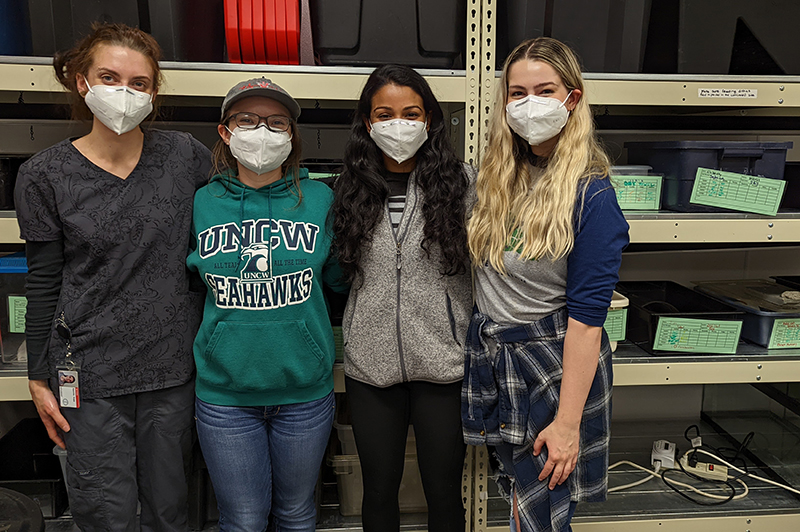
Some of the vet students who work on the Turtle Rescue Team (TRT). From left to right: Sabrina Kapp, TRT Co-President; Rachel Carpenter, TRT Co-President; Aswini Cherukuri, TRT Vice President; Emma Ferraro, TRT Social Media Chair. All are second year vet students. NC State University undergraduate students also volunteer for the TRT and help with treatment but they don’t take their own cases or perform procedures. Photo by Debbie Roos.
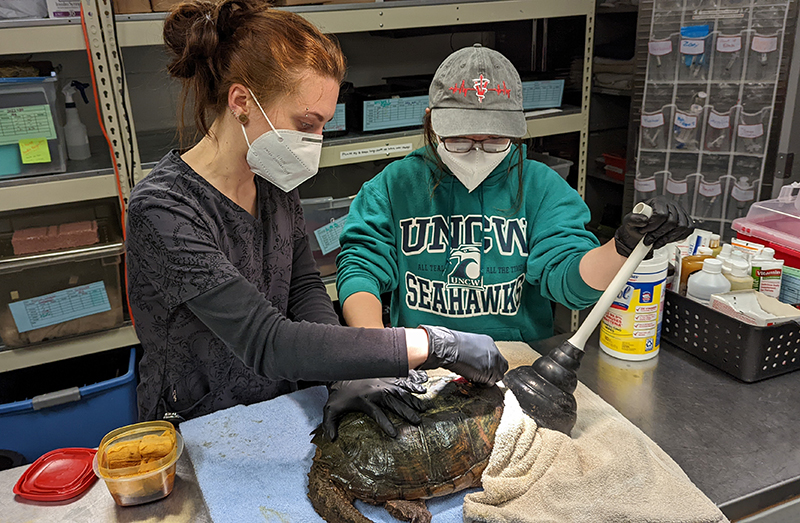
Sabrina and Rachel change a bandage on Icky Thump, a snapping turtle. The plunger immobilizes his head and allows the students to tend to him without worrying about being bitten. Photo by Debbie Roos.
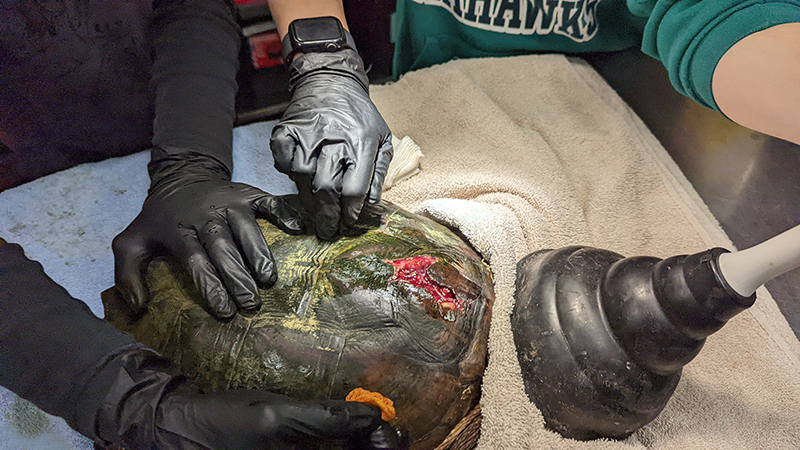
The wound to the carapace (top of the shell) exposed Icky Thump’s lung so they are keeping him out of deep water until his shell heals with granulation tissue. They applied a water-resistant Ioban to keep water out of his lungs which could cause issues or secondary infections. Photo by Debbie Roos.
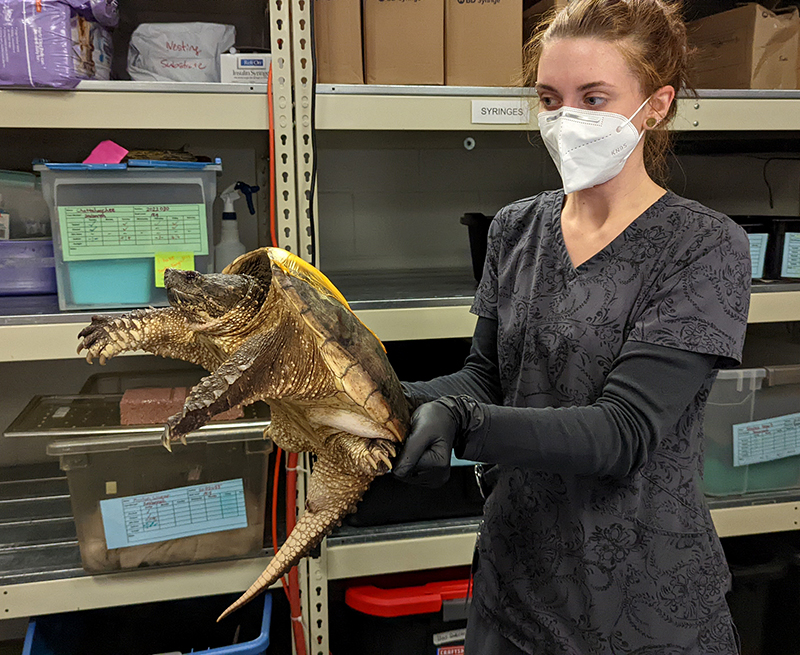
Sabrina demonstrates the proper way to pick up a snapping turtle to avoid getting bitten and/or injuring the turtle: grab them by the back of the shell so they can’t reach around with their head and take a bite! Picking them up by the tail can injure their spinal cord and should only be done as a last resort if they are in imminent danger. Photo by Debbie Roos.
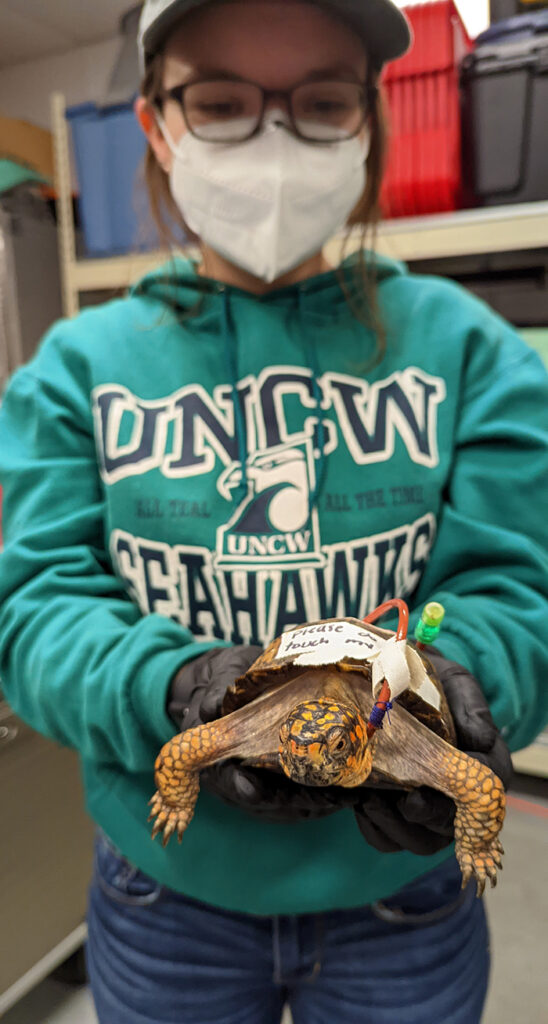
Rachel holds Matthew the box turtle. Matthew arrived in 2021 with facial fractures so receives nutrition through a feeding tube. Photo by Debbie Roos.
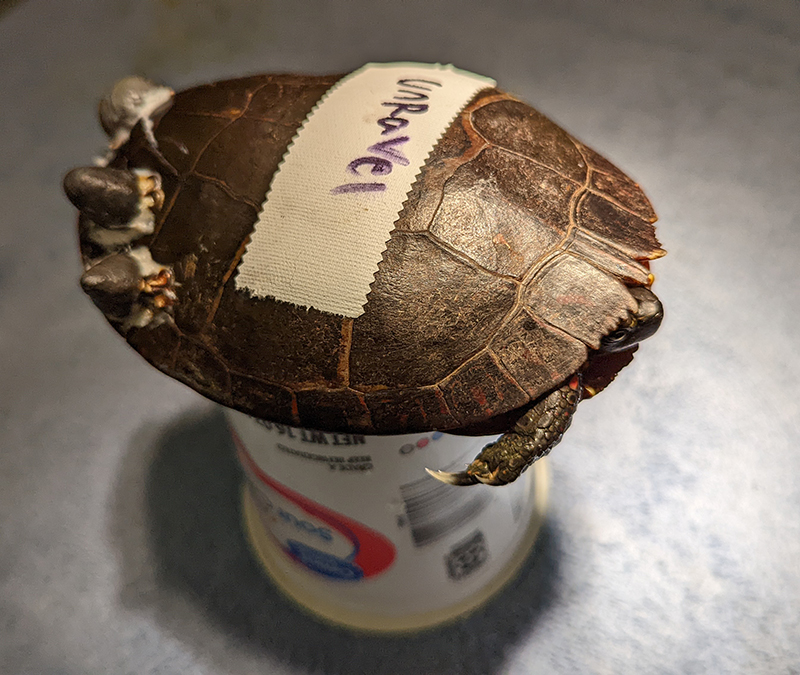
Unravel is an eastern painted turtle that had a fractured shell. He is placed temporarily on an inverted plastic cup to keep him from moving while they examine him. Turtles usually receive fluids, pain medication, and antibiotics if there is a lot of trauma and exposed tissue. Photo by Debbie Roos.

Donna the box turtle is missing part of her shell but has healed well and will be released soon. In time, in a matter of years, the shell will mineralize and slowly repair itself and regrow! Photo by Debbie Roos.

Emma holds Crutchie, a box turtle that arrived in 2021. Photo by Debbie Roos.

The students had to amputate Crutchie’s left rear leg but it has healed nicely and he will be released soon. Photo by Debbie Roos.
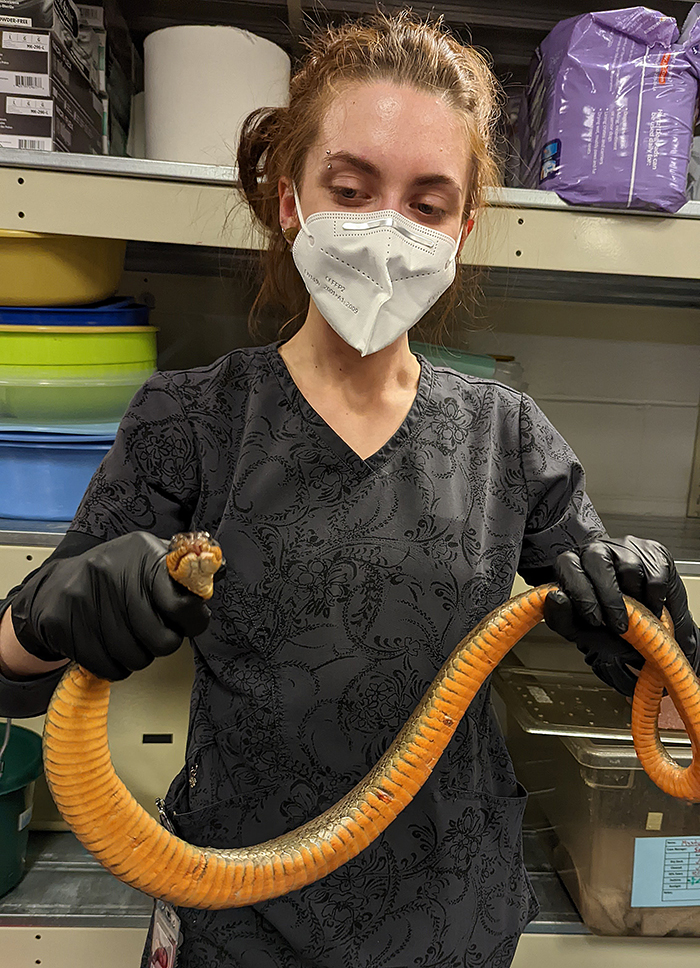
Sabrina holds Chattahoochee, a red-bellied water snake that has snake fungal disease. The disease can be fatal but I got an update a week later and she is improving! Photo by Debbie Roos.
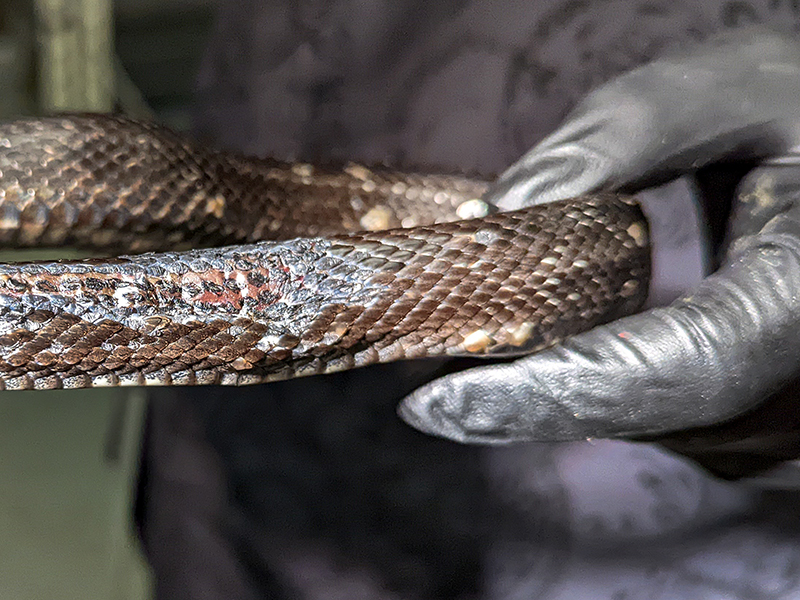
This poor black snake was brought in after bring caught on a glue board. Glue boards are used to catch rodents but in addition to being a cruel way to kill something they also catch non-target species. The glue board took off big chunks of the snake’s scales. Photo by Debbie Roos.
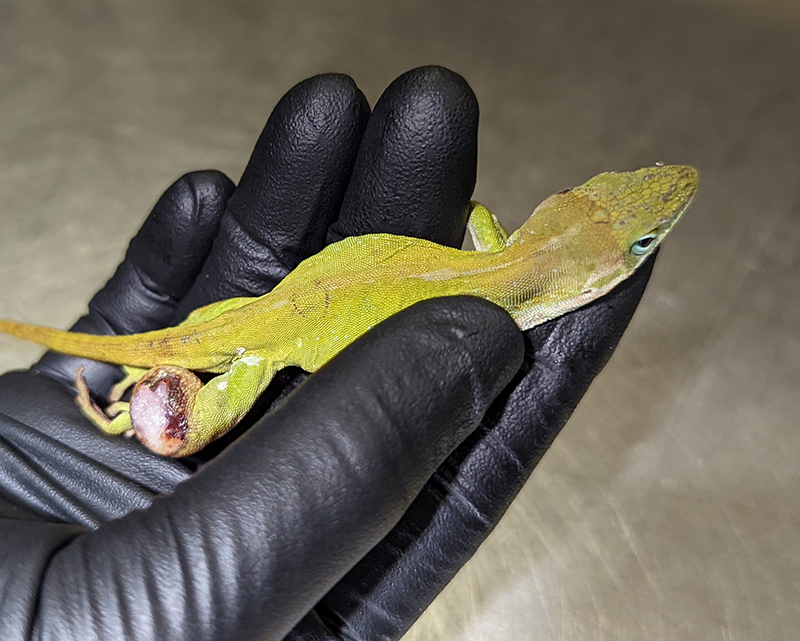
The students were not sure what caused the abnormal growth on this Carolina anole’s leg but it has since been amputated and he is doing well. Photo by Debbie Roos.
Success Stories: Examples of Turtles I Have Taken to the Turtle Rescue Team

I found this box turtle in the middle of Hwy 87 north of Pittsboro on Memorial Day weekend in 2021. I was so glad the Turtle Rescue Team accepts patients seven days a week and dropped him off within an hour of finding him. The TRT assigns names to all of their patients according to whatever the theme is that particular year. The 2021 theme was people’s names, so they named my turtle Winston. Photo by Debbie Roos.

When a turtle arrives with a fractured shell, tape is often used temporarily to reduce the fracture. Then they use glue, bra hooks, and wire to repair the shell (a technique pioneered by the students at the Turtle Rescue Team!). The hooks are glued on opposite sides of the fracture and then wired together to act as a suture. They cover the wires with soft industrial putty so hands aren’t cut on sharp edges when handling the turtles. Photo by Debbie Roos.

You can see how the wire pulls together Winston’s fractured shell. The shell slowly fuses together over time. Photo by Debbie Roos.
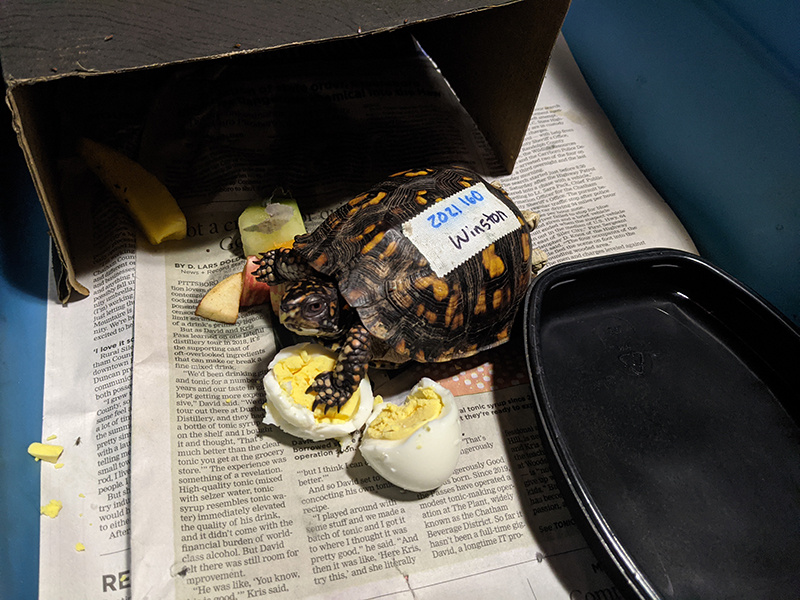
Winston spent about one month with the TRT while receiving intensive care and then came home with me for rehabilitation. I had already signed up to be a rehabber before I brought Winston in so was thrilled to be able to care for him myself. When you bring an injured turtle to the TRT there is no expectation that you will rehab that turtle. You can just drop it off and be done if that is what you want. But if you want to be more involved you can be a rehabber or help release turtles. Winston turned out to be a bit of a picky eater! I tried dozens of different fruits and veggies but his favorites turned out to be hard-boiled eggs, blueberries, and earthworms. He also got a daily soak in a separate tub of shallow water for 30 minutes, and I would periodically take him outside for supervised time in the sun. Photo by Debbie Roos.
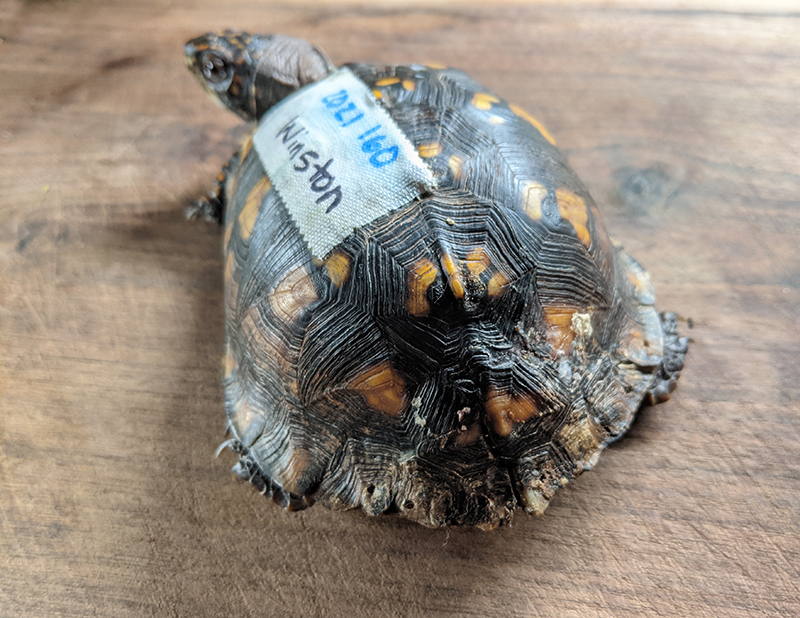
I took Winston back to the TRT for a re-check after five weeks in rehab but they said his shell still needed more time to heal. After spending 10 weeks with me he was finally cleared for release and they removed the hooks and wires that had held his shell together. See how nicely it healed! Photo by Debbie Roos.

This is Winston after being released. Turtles are ideally released within a mile of where they are found to put them back in their home range. My friend Allison Weakley helped me choose a release site…we looked at maps and drove around trying to find a nice forested area with a stream that wasn’t too close to the road. We put a lot of effort into it because we wanted to give Winston a great spot after all he had been through! We found a very nice landowner who let us release him on her property. I think of him often and hope he is doing well. Photo by Debbie Roos.
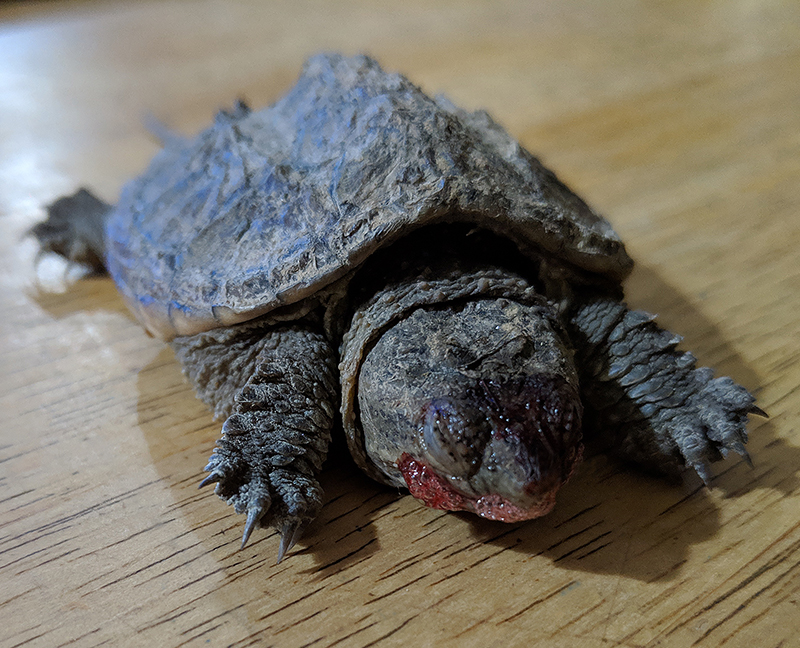
This was a young snapping turtle I found in the road very near my house a few years ago. He had blood coming out of his mouth and swollen eyes. I took him to the TRT and they estimated his age to be about a year old. He was so tiny he fit into the palm of my hand! I am amazed he survived being run over. Photo by Debbie Roos.
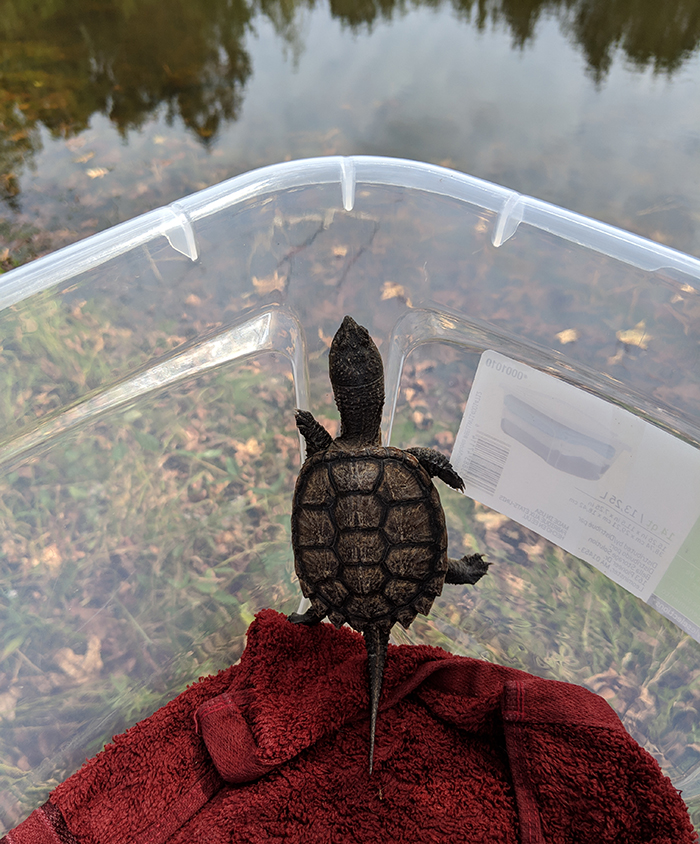
The TRT named him Pretzel Bites and he spent three months with them. I was able to release him and you can see he seemed pretty excited about it! Photo by Debbie Roos.
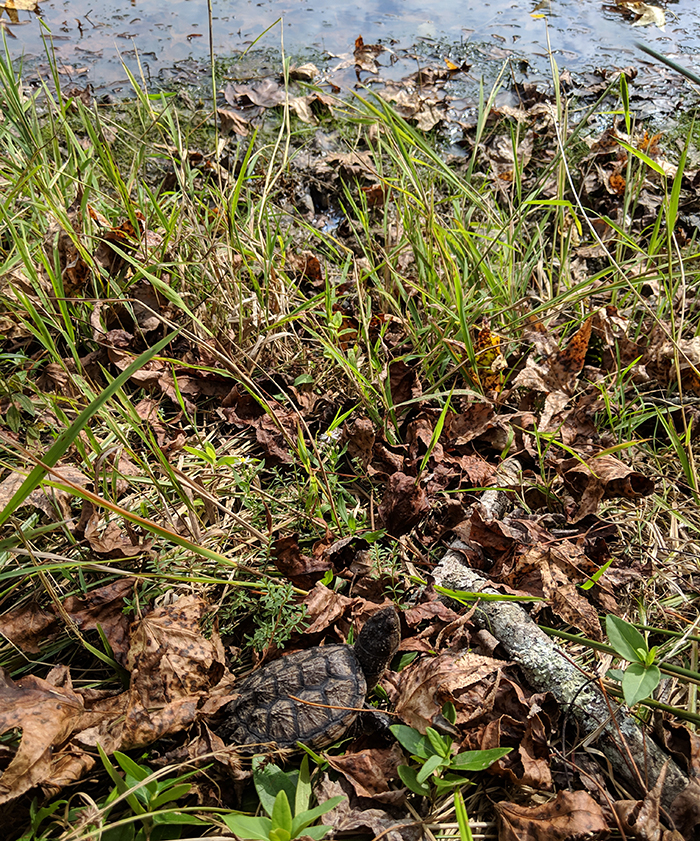
I was so happy to release Pretzel Bites into my pond, within a mile of where I found him. Photo by Debbie Roos.
What to Do if You Find an Injured Turtle
- Record the location where you found the turtle; if it’s able to be released after treatment it will be released close to where it was found
- Call the Turtle Rescue Team at 919-397-9675 and leave a message; they will call you back. You can also email turtle-rescue-team@ncsu.edu
- The TRT will consult with you and determine if the turtle needs to be brought in. If the injury is old or minor they may advise you to not interfere.
- If after consultation the TRT wants to see the turtle you must transport it to their clinic at the NCSU Vet School in Raleigh. They are open seven days a week but you MUST talk with the TRT in advance to arrange a time to drop off a turtle!
- When you drop the turtle off you fill out a form with the location and other info and you are given the option to release it if you want (if it survives and is able to be rehabilitated) but this is not required.
- They intake the turtle and assign it a case number and a name.
- Please consider giving them a donation if you can when you drop off the turtle because it costs money to provide care and they rely primarily on donations.
- The turtle is assessed and provided pain medication, fluids, and antibiotics if needed; the team administers wound care and any other testing or treatment.
- Once the turtle has made it through the first phase of intensive treatment and is stabilized, it’s placed with a volunteer rehabber while it continues to heal; this frees up space in the clinic for critical patients.
- Once the turtle is cleared for release a volunteer will release it close to where it was found.
Want to Support the Turtle Rescue Team?
- The Turtle Rescue Team relies primarily on donations to fund the clinic.
- VIsit their website to support the Turtle Rescue Team
- Interested in becoming a rehabber or helping with release? Email turtlerehabcoordinator@gmail.com
- Visit the TRT website or email turtle-rescue-team@ncsu.edu for more information
- Follow the Turtle Rescue Team on social media for regular updates!
- Facebook: Turtle Rescue Team
- Instagram: @turtlerescueteam
- Twitter: @turtle_rescue

Seeing turtles crossing roads is heart-breaking to me. I think it’s a miracle any of them survive that treacherous journey. I took this photo on Hwy 15/501 in 2021. I remember there was just an almost constant stream of cars in both lanes. I was so glad I was able to scoop him up and get him safely across. There are days where I have done four turtle assists just in the 25 minute commute to work! I actually try to leave the house early to allow extra driving time to help turtles. Photo by Debbie Roos.
Tips for Assisting Turtles Across the Road
- First tip: slow down and don’t drive distracted!
- If you see a turtle in the road or on the shoulder about to cross, pull off the road and put your emergency lights on.
- Be mindful of where you stop so that if cars swerve to go around you it doesn’t put them in the path of the turtle.
- Pick up the turtle and put it across the road and off the shoulder in the direction they were headed (if you put them back where they came from they will just try and cross again).
- For large snapping turtles, to avoid getting bit, pick them up at the back of the shell near their hind legs and tail (see photo above). I carry a shovel in my car during the busy turtle season to help nudge snappers along from the rear; I’ve also used the floor mat from my truck in a pinch. Lifting them up by their tail can cause a spinal cord injury and should only be done as a last resort if they are in imminent danger.
- Do not try to straddle snappers by driving over them thinking your tires will miss them…they often defensively rise up and that’s how their shell is damaged.
- BE SAFE! Do not jeopardize your safety or try to block traffic to help a turtle; this can have deadly consequences.


